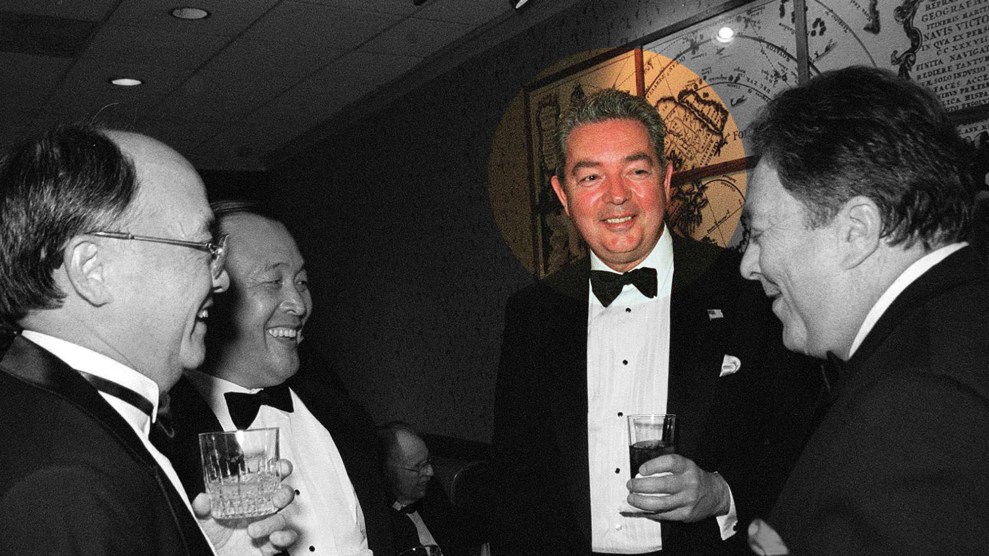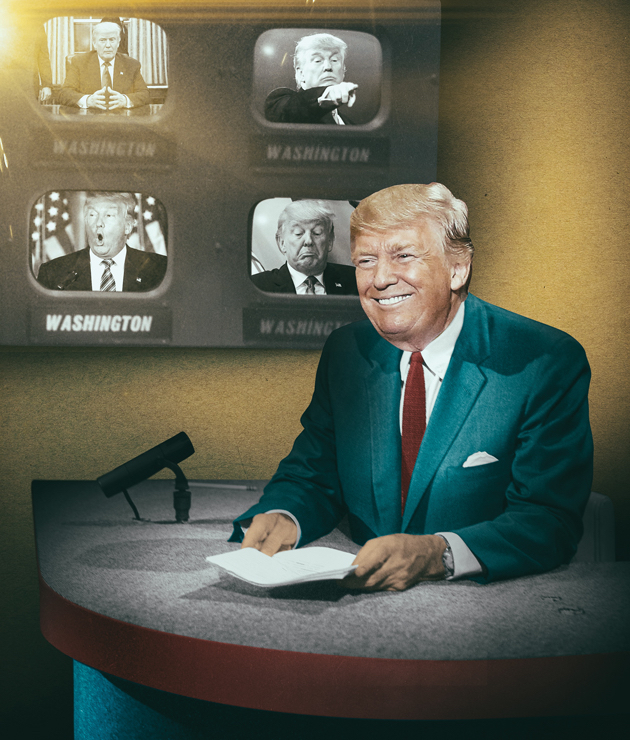
One evening in July, David Smith, the executive chairman of Sinclair Broadcast Group, strolled into the newsroom at WJLA, the ABC affiliate for Washington, DC, and the crown jewel of his company’s 193-station empire. Smith lacks the name recognition of Rupert Murdoch or the late Roger Ailes. But his company—with holdings concentrated in midsize markets like Tulsa, Flint, and Boise—owns more television stations than any other broadcaster in the country, reaching 2 out of every 5 American homes.
Station staffers thought it odd to see Smith, one of four brothers who control Sinclair, aimlessly show up at this evening hour. According to a source familiar with the newsroom, he assured them that he wouldn’t be staying long; he was just killing time until a dinner appointment. Before he left, he confided that he was headed to the White House, to dine with President Donald Trump himself.
At 67, Smith has thick jowls and a head full of silver hair with wide-set eyes shaped like crescents. A longtime Republican donor who travels in rarefied circles (he once hosted a party for Supreme Court Justice Clarence Thomas), Smith lives outside Baltimore in Maryland’s horse country, where his company is headquartered. Over the past 30 years, Smith and his brothers have transformed a small family company with three TV stations into a media goliath with entrée to the Oval Office. Along the way he has shown no qualms about using his stations for political purposes and has salivated at the prospect of acquiring more under Trump’s friendly regulatory regime. In April, Sinclair hired Boris Epshteyn, a former Trump White House staffer and frequent television surrogate, as its chief political analyst. Epshteyn’s softball interviews with administration officials and brusque commentaries are slavishly pro-Trump; a Baltimore Sun columnist wrote that the segments are “as close to classic propaganda as anything I have seen in broadcast television in the last 30 years.”
After a campaign season spent boosting Trump, Sinclair looks set to grow even bigger thanks to the president’s appointees at the Federal Communications Commission: In May, the company announced a $3.9 billion deal to acquire Tribune Media’s 42 TV stations, which would give Sinclair access to New York, Los Angeles, and Chicago, the nation’s three largest media markets. The deal—and, for many, Sinclair itself—came to prominence after John Oliver blasted it in an episode of his HBO show, Last Week Tonight, that has been seen more than 6 million times on YouTube. Experts believe the FCC will approve the merger, despite critics on the left and right who argue the deal will give Sinclair far more reach into American households than the law allows.
“The most important force shaping public opinion continues to be local, over-the-air television,” says Andrew Jay Schwartzman, a senior attorney at Georgetown’s Communications and Technology Law Clinic. “That’s the underlying premise of the FCC continuing to regulate broadcast ownership.”
But under the leadership of Ajit Pai, a Republican who joined the commission in 2012 and whom Trump elevated to chairman, the FCC has seemingly gone out of its way to grease the wheels for the Sinclair-Tribune merger, reinstating a rule from the Reagan era that could help the company avoid limits on media consolidation. “The FCC is gaming the rules to directly benefit Sinclair,” says Craig Aaron, the president of the public interest group Free Press.
If the merger is approved, Sinclair’s broadcasts will reach 72 percent of all households. Some media analysts have speculated that with Fox News reeling from cascading sexual harassment scandals, Sinclair senses an opportunity to build a rival conservative network. David Smith is reportedly eyeing a collaboration with Steve Bannon, the former Trump White House chief strategist who leads Breitbart News. There have also been reports, which Sinclair denies, that the company is pursuing the ousted Fox host Bill O’Reilly as well as Sean Hannity.
Sinclair’s Plan to Take Over Your Television
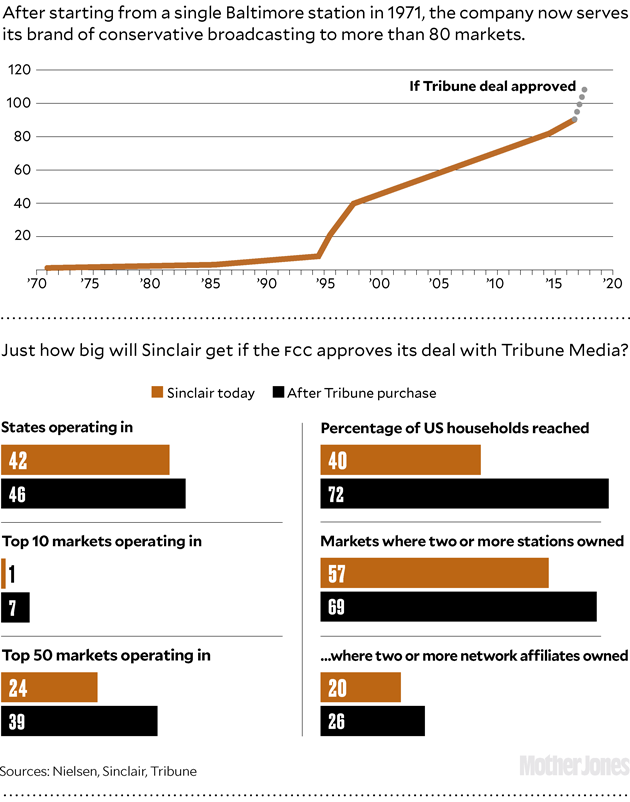
Sinclair has downplayed talk about taking on Fox, and Smith, who declined to comment for this story, rarely speaks about the broadcaster’s larger plans. The two companies are clearly in different lines of business. Fox News operates a single channel that shovels red meat, 24 hours a day, to dedicated conservative viewers. Sinclair’s stations around the country slip hardline political content between local weather, high school sports, and city council reports—broadcasting to a mass audience that, survey after survey shows, trusts local news more than any other medium.
“Sinclair is exploiting that credibility or trust that people have invested in their local stations by injecting a political message into it,” warns David Zurawik, the Baltimore Sun‘s veteran TV critic and a close company watcher. “Boris Epshteyn is wrapped in the packaging of the trusted local newsperson.”
In Baltimore, they call it TV Hill. On the north side of the city, it’s home to three of the city’s four biggest stations. There’s WJZ, the mighty CBS affiliate, at the top. Next is WBAL, the Hearst-owned NBC affiliate, its massive transmitter looking out over the city. And at the bottom of the Hill, before you cross the West 41st Street bridge, is WBFF, known to locals as Fox 45, the first station in the Sinclair empire.
Julian Sinclair Smith, an electrical engineer, took a gamble when he founded WBFF. As Smith’s wife, Carolyn, later recalled, the family used “every penny we had” to launch in April 1971. Its call letters stood for “We’re Baltimore’s Finest Features,” but as one of only two independent stations in the city, marooned high on the dial in ultra high frequency (UHF), it struggled to attract quality programming. When early viewers tuned their sets to Channel 45, they usually found reruns of Lassie, black-and-white movies, and kids’ fare like Captain Chesapeake.
By 1986, the family business had grown to three stations, one in Baltimore, one in Pittsburgh, and one in Columbus, Ohio. Under threat from an outside buyer, Smith’s four sons—David, J. Duncan, Robert, and Frederick—took over and renamed it Sinclair Broadcast Group, after their ailing father. (He died from Parkinson’s disease in 1993.) None of the Smith sons had any formal experience running a broadcast media company, though David, the second oldest, had helped found a TV transmitter company. Years earlier, he’d also been a partner in a side project called Ciné Processors that churned out bootlegs of porn movies like Deep Throat from the basement of a building owned by his father’s business. “All you had to do was get the film and sound in sync, and you had something that was not available anywhere,” David Williams, Smith’s partner in the business, told author Eric Klinenberg in Fighting for Air: The Battle to Control America’s Media. “We’d just solicit guys in the strip joint area and tried to sell them.”
From the day he took over Sinclair, David Smith, the new CEO, whose desk featured a rattlesnake head and a toy shark, had grand ambitions for his small company. Seated together in a bullpen-style office on the WBFF building’s first floor—the better to keep an eye on each other—the Smith brothers used every tool at their disposal to expand their company’s reach.
Standing in their way was the duopoly rule, a 1940s-era policy preventing broadcasters from owning more than one station in a single market. To take over a second station in Baltimore, their mother, Carolyn Smith, and a Pittsburgh-based African American broadcaster named Edwin Edwards Sr. established a company called Glencairn. With financial backing from the Smith family, Glencairn acquired WNUV, but Sinclair would share advertising sales and staffing and provide 20 hours of programming a day. While Edwards controlled Glencairn’s voting shares, according to FCC records, profit from the new stations would flow through the company to the Smith family.
Sinclair used the tactic to gobble up stations in markets where it already had a presence. A veteran broadcast industry lawyer who has worked on many sidecar agreements told me it was no coincidence that Sinclair chose a minority broadcaster as its business partner. Under President Jimmy Carter, the FCC had introduced policies designed to encourage greater minority ownership of TV stations, and according to the lawyer, it cited that goal in its decision approving an early Sinclair deal with Edwards. Critics including the National Association of Black Owned Broadcasters called these arrangements a sham and a front and accused Sinclair of violating the law. Edwards said Sinclair’s opponents were standing in the way of a successful African American businessman and “should be ashamed of themselves.”
The Telecommunications Act of 1996 deregulated the industry and unleashed a wave of consolidations, and Sinclair embarked on a buying spree, quickly gaining a reputation for its low-budget approach. “David doesn’t build expensive newsrooms,” a former Sinclair executive says. “If anything, he’s the anti.” According to another former colleague, “Public service journalism was not what he really focused on.”
By the late 1990s, Sinclair had grown its portfolio to almost 60 stations reaching 24 percent of households, making it among the largest broadcasters in America. Smith had also taken the company public, and its revenue soared past $500 million. “We’re forever expanding—like the universe,” Smith told the Baltimore Sun.
Even as the company boomed, David Smith and his brothers kept a low profile. Smith sometimes drove a pickup to work and wore jeans to business meetings. There was no corporate PR team. It helped that it wasn’t Sinclair’s name viewers in Rochester or Indianapolis saw every evening on the 10 p.m. news—it was the four letters and familiar faces of their local TV station. Closer to home, though, David Smith earned a bit of notoriety for his arrest in the mid-1990s after soliciting a prostitute in a police sting. He was allegedly receiving a blow job in a company-owned Mercedes when he was arrested and charged with a misdemeanor. Smith struck a deal with prosecutors requiring Sinclair stations to produce segments highlighting the state’s drug courts. His employees, in other words, would fulfill his community service for him.
Sinclair’s rapid growth also caught the attention of the FCC, and in proceedings surrounding a round of proposed acquisitions in 1998, the commission examined the company’s use of sidecar agreements. Edwards provided the FCC with incorrect figures related to the purchases, leading the commission to wonder “whether he is actively involved” in his company. In the end, the commission fined Sinclair $40,000 for exercising too much control over Glencairn’s acquisitions, in violation of US law. Glencairn was also fined $40,000. As Michael Copps, a Democratic commissioner, wrote in a blistering opinion, the fine “merely points out that lines have been crossed, while allowing Sinclair to run over these lines and to continue its multiple ownership strategy.”
The FCC’s scrutiny caused Smith and his brothers to see the value of friends in Washington. Between 1997 and 2002, the Smith brothers donated nearly $200,000 to Republican candidates and committees in Maryland and at the federal level. The Smiths were also generous with Democrats, when they were in a position to help: One former Sinclair executive told me the company’s political giving “was primarily FCC-driven. Who could be friendly? Who could help them with the FCC?”
Bob Ehrlich, a Republican congressman whose district was home to Sinclair’s headquarters north of Baltimore, received tens of thousands of dollars in campaign donations. The congressman sat on a subcommittee overseeing the commission and sent sharply worded letters to the FCC in 2001 asking after the status of the proposed 1998 acquisitions. The commission ultimately approved every deal but one in Sinclair’s favor.
“The management of WBFF Fox 45 stands behind the president,” the anchor said, “and our nation’s leaders in the vow that terrorism must be stopped. If you agree, make your voice heard.” It was days after the attacks of September 11, 2001, and soon all 62 of Sinclair’s stations would deliver messages like this, to millions of viewers around the country.
The attacks brought politics into the company’s newsrooms in a new way. “It was a great place to work until 9/11,” says Kirk Clyatt, a former anchor and weather reporter at WBFF in Baltimore. “It was almost like you could feel the wind change.” The on-air editorials were unprecedented for Sinclair. While scripts noted that the messages represented the views of “station management,” there was unrest in Sinclair’s newsrooms among a generation of journalists trained to be neutral and nonpartisan. That wasn’t how Sinclair executives saw it: If they were guilty of anything, one executive said, it was “being patriotic during a time of tragedy.”
But the company followed up with more—and more strident—political content. As the major networks rushed to fill airtime with retired generals after the attacks, Sinclair found its own pundit in Mark Hyman. A former Navy intelligence officer who had worked as a Sinclair lobbyist, Hyman went on WBFF in the weeks after the attacks to cheer on President George W. Bush and scold other media for their unfair and unpatriotic coverage. Sinclair soon elevated Hyman to be its chief commentator and designated his editorials, titled “The Point,” as must-runs. Hyman’s segments were taped near Baltimore and distributed nationwide to Sinclair’s stations, which were required to knit them into their local news broadcasts. For the viewer, the effect could be jarring: one minute, traffic and sports. The next, a centrally recorded, straight-to-camera clip of, say, Hyman visiting Iraq after the 2003 US invasion in search of “good news,” or a Hyman commentary claiming that “terrorist leaders would dearly love to see President Bush replaced with Senator Kerry.”
Hyman and David Smith both argued that the national networks’ news operations and cable giants like CNN were too liberal, and that Sinclair could balance out the negative, anti-war, anti-Bush bias of its competitors. (Meanwhile, Sinclair pursued buying affiliates of those same networks.) During a deposition in a colleague’s contract dispute, Stuart Zang, a former producer for Hyman, said he was told to read three books of right-wing media criticism after he was hired: Slander by Ann Coulter, Bias by Bernard Goldberg, and a tome called Coloring the News: How Crusading for Diversity Has Corrupted American Journalism.
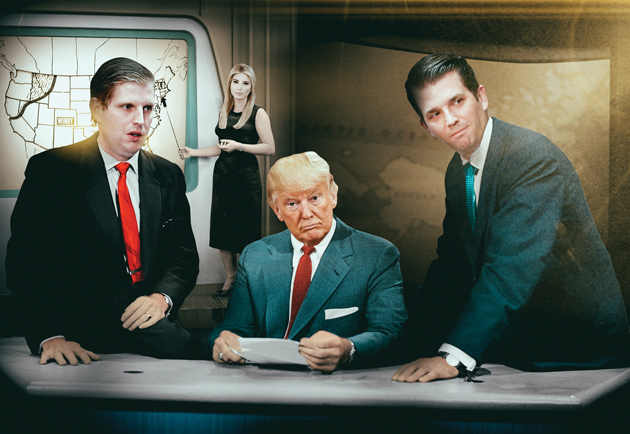
In 2002, Ehrlich, Sinclair’s congressman, took on Kathleen Kennedy Townsend, the state’s Democratic lieutenant governor, in the Maryland governor’s race. As former WBFF political reporter Jon Leiberman later told GQ, newsroom staffers at Sinclair’s flagship station were tasked with taking down Townsend. “All of our resources were used to go after her,” he recalled. After she lost the election, the Baltimore Sun reported that Ehrlich had failed to report a series of discounted flights he received during the campaign from a helicopter company controlled by J. Duncan Smith, a potential violation of campaign finance laws. The scandal was dubbed Choppergate, and Ehrlich voluntarily repaid $26,600.
That year, Sinclair created a national news desk to produce segments for stations’ local newscasts, and in 2003 it followed up with a Washington bureau. Sinclair’s political leanings gained more widespread attention in 2004 when Ted Koppel planned to spend an episode of Nightline reading the names of soldiers killed in Iraq. Sinclair ordered its ABC affiliates not to run the show, saying it was “motivated by a political agenda.” Sen. John McCain (R-Ariz.) called Sinclair’s move “unpatriotic.” During that year’s presidential campaign, Sinclair sparked a national uproar when it planned to air Stolen Honor, a controversial documentary widely seen as a hit piece on then-Sen. John Kerry (D-Mass.), the Democratic nominee. Amid the backlash, Mark Hyman compared news networks that refused to report Stolen Honor‘s allegations about Kerry’s anti-Vietnam War activism to Holocaust deniers. After Sinclair’s DC bureau chief described the documentary to a Baltimore Sun reporter as “biased political propaganda with clear intentions to sway this election,” the company fired him and sued him for breach of contract.
The outcry drove the company’s stock price to its lowest point in three years. In the end, Sinclair retreated, instead airing a more balanced piece on the use of documentary films during political campaigns that included excerpts of Stolen Honor.
The fracas brought the company unprecedented attention: “Keep your eye on Sinclair Broadcasting,” New York University professor and media critic Jay Rosen wrote the day after the 2004 election, adding that Sinclair represented “a new kind of media company—a political empire with television stations.”
Sinclair receded from the headlines during the Obama years. The Great Recession battered the company’s balance sheet, pushing it to the brink of bankruptcy by mid-2009. But unlike some of its competitors, Sinclair avoided collapse through heavy cost-cutting, a refinancing of its debts, and an influx of political ad spending unleashed by the Supreme Court’s 2010 Citizens United decision. Sinclair had recovered enough by 2011 to embark on a multiyear shopping spree. By 2015, it had acquired another $3 billion worth of TV properties, for a total of 151 stations—more than twice as many as it had owned or operated a decade earlier.
The company’s size was again drawing scrutiny from a Democrat-controlled FCC. When Tom Wheeler took the commission’s helm in 2013, he aimed at a loophole that allowed broadcasters to avoid the FCC’s consolidation limits by dividing the audience figures of their UHF stations—found on channels 14 and higher—in half. The rule dated to the mid-’80s, when viewers favored lower-numbered stations. But it became even more outmoded after 2009, when broadcast television went digital and technical requirements forced most lower-numbered stations to start transmitting in UHF. Wheeler believed broadcasters were abusing the rule to gobble up stations while staying under the national ownership cap of 39 percent. So he eliminated it, throwing up a barrier to future growth by Sinclair.
But when he stopped the use of the sidecar agreements that Sinclair had pioneered to operate multiple stations in the same market—”a pure scam,” he put it, echoing statements in FCC documents—he ran up against the company’s allies in Congress. One of Maryland’s US senators, Barbara Mikulski, a recipient of almost $20,000 in Smith family donations and a stalwart liberal who was then the chair of the Appropriations Committee, barred the commission from spending any money to enforce Wheeler’s ruling, according to a person familiar with the move.
Sinclair enthusiastically embraced the chance to influence the 2016 election and perhaps sway its viewers to select a president likely to install commissioners favorable to the company’s agenda. “Sinclair sees news first and foremost as a profit center and second as a vehicle for promoting its interests,” warns Schwartzman. “And its political interests promote its business interests.”
The company’s first choice was not Donald Trump, but Dr. Ben Carson, the retired Johns Hopkins neurosurgeon. Carson was something of a celebrity in Baltimore and had appeared at Sinclair-sponsored town hall events in the region. A precampaign hourlong biographical infomercial about Carson was carried on multiple Sinclair stations, and WJLA, the Sinclair station in DC, ran an ad promoting it.
The infomercial was the work of Armstrong Williams, a close friend and political consultant to Carson who was also a broadcaster and a Sinclair business partner. A gadfly of sorts in Republican circles, Williams hosted a talk show in the 2000s carried by Sinclair and interviewed Bush administration officials. Williams later admitted he had received more than $180,000 from Bush’s Education Department to promote its policies—a disclosure he never made on air or in his syndicated columns. The Government Accountability Office eventually concluded that the arrangement violated a federal ban on “covert propaganda.” (Williams admitted no wrongdoing but paid back $34,000.) The scandal did nothing to tarnish Williams in the eyes of Sinclair CEO David Smith—former Sinclair employees who worked with Smith and Williams describe the two as good friends. In 2015, Sinclair sold three stations in cities where it ran the risk of violating the duopoly rule to a company owned by Williams, while inking local management agreements to continue their operations.
Former staffers on Carson’s presidential campaign say Carson, Williams, and Sinclair were deeply intertwined. Carson’s staff planned an elaborate campaign rollout event in Detroit, Carson’s hometown, complete with a church choir and 1,700 guests brought in for the day. National media flew in from across the country to cover it.
At the rehearsal the night before, Doug Watts, who was Carson’s communications director, remembers a reporter approaching him with a peculiar question. “Why are we here?” the reporter asked. “You just announced.” Watts chuckled. “Ben’s going to make his announcement tomorrow,” he said. No, the reporter said, Carson just announced in an interview on the Sinclair station in Palm Beach, Florida.
In fact, the interview—pretaped weeks earlier at Carson’s home in West Palm Beach—was airing on Sinclair stations across the country, from Florida to Ohio to South Carolina. Jeff Barnd, Sinclair’s national political correspondent, had landed the sit-down with Williams’ help. “He did it so that he could give Sinclair this exclusive,” Watts says. (Williams declined to comment for this story.)
It wasn’t the only time Williams and Sinclair used their massive reach to benefit the Carson campaign, Watts says. Once, Watts told Williams he was searching for archival footage of riots in Baltimore to use in a campaign spot. The clips Watts had found were all marked for editorial use only, meaning they couldn’t air in a political ad. Williams offered to help and soon sent four or five archival clips from a Sinclair station in Baltimore. When Watts pointed out that the footage had the same restrictive labels, he remembers Williams telling him, “You go ahead and use it. I’ll take care of it.” Several times, Watts recalls Williams secreting Carson away to gently question him on a range of subjects, triggering concerns that Williams would air the tapes on stations he owned: “I said, ‘Armstrong, that’s what’s called an in-kind contribution,'” Watts remembers. “It seems to me it puts your [broadcast] license in jeopardy. It puts the campaign in jeopardy.”
After Carson dropped out of the race in March 2016, Sinclair threw its weight behind Trump. A Politico story detailed how Trump’s son-in-law, Jared Kushner, speaking in a postelection off-the-record session, described an arrangement where Sinclair had aired interviews with candidate Trump without commentary in exchange for greater access to the campaign. “It’s math,” Kushner reportedly said, boasting about the benefits of reaching Sinclair’s massive audience. While Sinclair says Kushner was describing a standard offer made to both campaigns to conduct extended interviews with local anchors, a Washington Post analysis found that Sinclair stations ran 15 “exclusive” interviews with Trump, 10 with running mate Mike Pence, and 10 more with campaign surrogates. By contrast, the company’s stations aired zero interviews with Hillary Clinton, five with Sen. Tim Kaine, Clinton’s pick for vice president, two with Chelsea Clinton, and none with any other top surrogates. According to the Post, Sinclair higher-ups suggested questions with a strongly anti-Clinton bent to local reporters.
Just before the campaign, Sinclair took steps to expand its style of news online. In August 2015, the company bought the name and technology from the remains of a failed San Francisco startup, Circa News. The new venture’s announcement promised an “independent digital news site” for readers who “value raw content, differing perspectives, and personalization.” Circa would produce stories for the web and video segments for Sinclair’s stations.
Sinclair’s pick to run Circa was a former Washington Times editor named John Solomon, who has a conservative slant and a history of writing stories damaging to Democratic politicians. Ten current and former Circa staffers told me that Solomon pitched the new venture as a down-the-middle, nonpartisan news organization: “BuzzFeed with a brain,” is how one remembers Solomon putting it. But as the presidential campaign ramped up, staffers, who asked to remain anonymous because they signed nondisclosure agreements or fear retribution, say Circa adopted a notable rightward tilt and an increasingly hostile stance toward Clinton. Solomon hired a former Republican National Committee spokesman named Raffi Williams to be a political reporter, though he previously had little formal journalism experience. Williams, the son of former NPR reporter turned Fox News pundit Juan Williams, is now a spokesman at Secretary Ben Carson’s Department of Housing and Urban Development.
The Big Power of the Small Screen
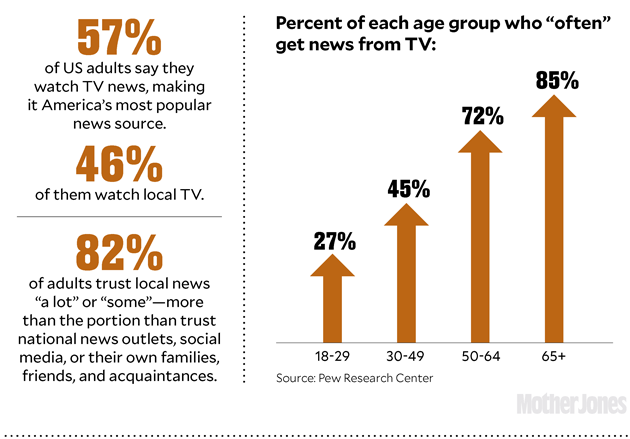
Weeks away from the election, Solomon told staffers he had landed a major scoop, one that—as he breathlessly wrote in a draft script—”will make you forever question how politics works.” The scoop, it turned out, came from James O’Keefe, the conservative provocateur best known for undercover sting videos that toppled the progressive activist group ACORN. (He was later sentenced to three years of probation and 100 hours of community service for entering a US senator’s office under false pretenses.)
O’Keefe had spent six months running a hidden-camera investigation into Scott Foval and Robert Creamer, both Democratic operatives. Solomon brokered a deal to edit O’Keefe’s raw footage into a multipart documentary. An early version of a script Solomon wrote reads like a bad political thriller. “Politics in Washington has always had its dirty trick operatives, both on the Republican and Democratic sides, though none have been chronicled with the level of detail that the undercover journalists captured,” the script says. “It’s the sort of stuff you’d expect to hear from the diabolical Frank Underwood’s mouth during an episode of House of Cards, except this is real life.”
After Creamer learned he’d been targeted by O’Keefe and that Circa was involved, his lawyers warned Sinclair that they believed O’Keefe and his team faced legal liability for the tactics used to infiltrate his firm, and that Circa could be liable for coordinating with O’Keefe. After legal discussions, the Circa series never ran.
O’Keefe eventually released some edited footage on his own site, purportedly showing Foval and Creamer discussing hypothetical ways to stir up violence at Trump rallies. Creamer, then a contractor at the Democratic National Committee, told me he pulled out of the contract to avoid causing any harm to the Clinton campaign. (Foval was laid off.) In June, Creamer and his firm sued O’Keefe and his team, alleging violations of local and federal wiretap laws, among other claims. O’Keefe says the lawsuit is “frivolous.” When I spoke to Creamer in September, he told me his lawyers had been unable to serve one of the defendants, Allison Maass, who had created a fake identity to get an internship and shoot undercover footage at Creamer’s firm. Maass’ Twitter bio doesn’t list her residence, but it does list her current employer: Circa.
David Smith was fired up. On the day after Trump’s election, he spoke at a media conference at the Waldorf Astoria hotel in Manhattan. Trump’s victory, Smith told the audience, was “a really serious opportunity to seek complete deregulation” of broadcasting. “If Donald Trump is as deregulatory as he suggests he is,” he said, “we’re going to be the first industry in line.”
On the day before Trump’s inauguration, Smith, Armstrong Williams, and Sinclair’s new CEO, Chris Ripley, had a meeting in Washington with FCC Commissioner Ajit Pai. In his five years on the commission, the 44-year-old Pai, an ex-Verizon lawyer and staffer to former Sen. Jeff Sessions, developed a reputation as a sharp and well-spoken advocate for the industry, fighting Wheeler’s steps to limit concentration.
Pai was no stranger to Sinclair. Just two months before, he had spoken at the company’s annual meeting for general managers at the Four Seasons in Baltimore, taking a short private meeting with Smith afterward. (What he told the managers is unclear: Sinclair declined to comment for this article, and Pai’s office said it couldn’t locate any remarks or notes for the event in response to a Freedom of Information Act request.) In the January meeting, Smith, Williams, and Ripley argued that the sidecar agreements utilized by Sinclair were vital to the industry, and to a minority broadcaster like Williams. (In March, after opening with a brief disclaimer that he owned TV stations regulated by the FCC, Williams hosted Pai for a friendly interview on his show The Right Side, which airs on Sinclair stations.)
When Trump took office, he elevated Pai to serve as chairman. Since then the commission has made one move after another that has benefited Sinclair. Two weeks into the administration, the FCC tossed out what remained of Wheeler’s policy clamping down on sidecar agreements. Then, in April, the FCC voted to bring back the ultra high frequency discount, setting the groundwork for Sinclair’s purchase of Tribune Media’s 42 stations. Without the discount, the combined company is estimated to reach 72 percent of households—far above the 39 percent limit. Sinclair officials note that the new FCC changes benefit many companies, not just Sinclair. At an industry luncheon, Ripley praised the chairman’s work to cut regulation: “Thankfully, we’ve got Chairman Pai.”
As the company expands, it also seems to be growing more assertive about its politics. Stations are required to air terrorism alerts daily. Sinclair responded to criticism of its must-run Boris Epshteyn segments by tripling the number of times stations are mandated to air them each week. In March, the company’s executive in charge of news, in a must-run segment of his own, cribbed a favorite term of Trump’s when he lashed out at unnamed national media outlets for peddling “fake news.”
The FCC is reportedly investigating a 2016 incident where Sinclair newscasts aired months of paid segments promoting a Utah hospital without proper disclosure. Smith has reportedly said the violation could cost the company millions of dollars. Travis LeBlanc, a former head of the FCC’s enforcement bureau, warns it could also delay the Tribune deal: “It would be out of the ordinary and inappropriate for the commission to approve any merger—or any transaction—if there is an unresolved enforcement investigation.”
While Sinclair awaits federal clearance for the purchase, there are already rumblings that the FCC will soon consider further deregulation of its duopoly rule and ownership cap—changes that could unleash yet more consolidation on the airwaves. Which, according to Ripley, is precisely what Sinclair wants. “We think the industry needs to consolidate to two or three large broadcasters, and really just one to two strong local players in each market,” he told shareholders in August. If the FCC rolls back the regulations, he said, it could create “significant savings” for companies like Sinclair—while allowing them to spread their message to more Americans than ever before.
Additional reporting by Russ Choma.
What is Sinclair showing you?
If your TV station is owned or operated by Sinclair Broadcasting, tell us what you’re seeing. Not sure? Check for your station on this map.
We may share your response with our staff and publish a selection of stories which could include your name, age, and location. We respect your privacy. Your email address will not be published and by providing it, you agree to let us contact you regarding your response.
Photo credits: CBS/Getty (3); Joshua Roberts/Reuters; Jim Watson/AFP/Getty; Carlo Allegri/Reuters; Pool/Getty; Paul J. Richards/AFP/Getty; Olivier Douliery/DPA/Zuma; Jeff Vinnick/Getty; Jaap Arriens/Nurphoto/Getty

